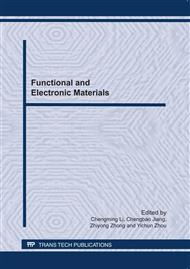p.333
p.339
p.343
p.348
p.354
p.359
p.366
p.370
p.375
Pinning Effects on the Dielectric and Ferroelectric Properties of Mn-Doped Ba(Zr0.06Ti0.94)O3 Ceramics
Abstract:
Lead-free ceramics with the composition of Mn-doped Ba(Zr0.06Ti0.94)O3 – xmol%MnO2 (BZT6-xMn, x=0, 1 and 2) have been synthesized by a mixed oxide process. Structure and micrograph characterization were examined using X-ray diffraction (XRD) and scanning electron microscopy (SEM), which revealed that all samples have the orthorhombic phase with dense and the uniform microstructure. The grain size of Mn-doped BZT6 ceramics decreased with increasing MnO2 doping. The effect of MnO2 doping on the dielectric and ferroelectric properties was also investigated. The maximum dielectric permittivity decreased dramatically with increasing MnO2 doping in the BZT6 ceramics. A peculiar double-hysteresis-like loop was observed. Mn ions as acceptor doping occupy the B site of ABO3 in the form of Mn2+ and Mn3+, which brought an increase in the oxygen vacancies concentration. The defect dipole model was explained the pinning mechanism.
Info:
Periodical:
Pages:
354-358
Citation:
Online since:
June 2011
Authors:
Keywords:
Price:
Сopyright:
© 2011 Trans Tech Publications Ltd. All Rights Reserved
Share:
Citation:


